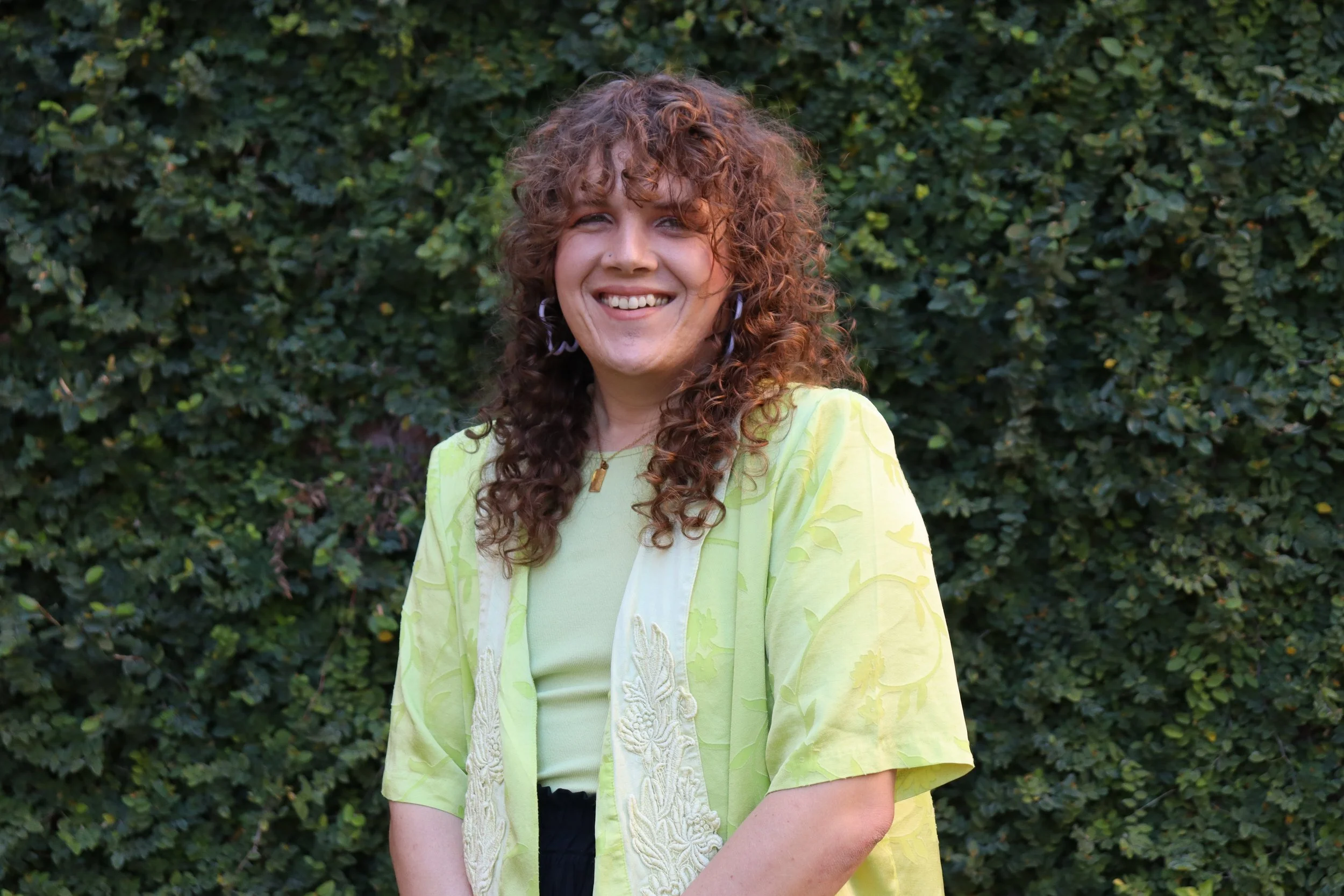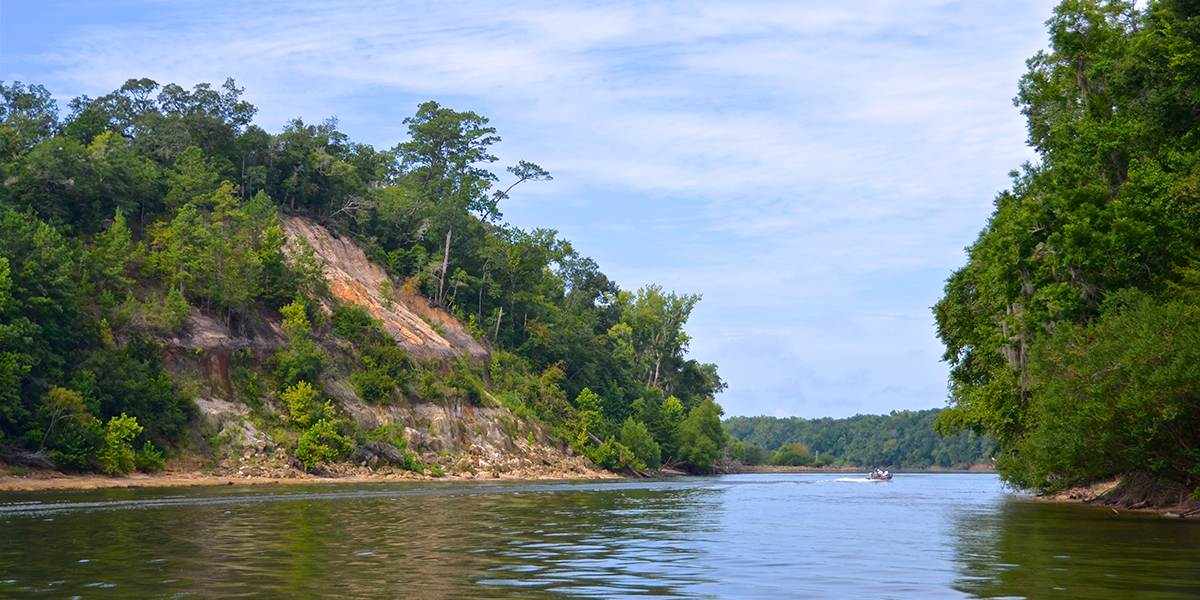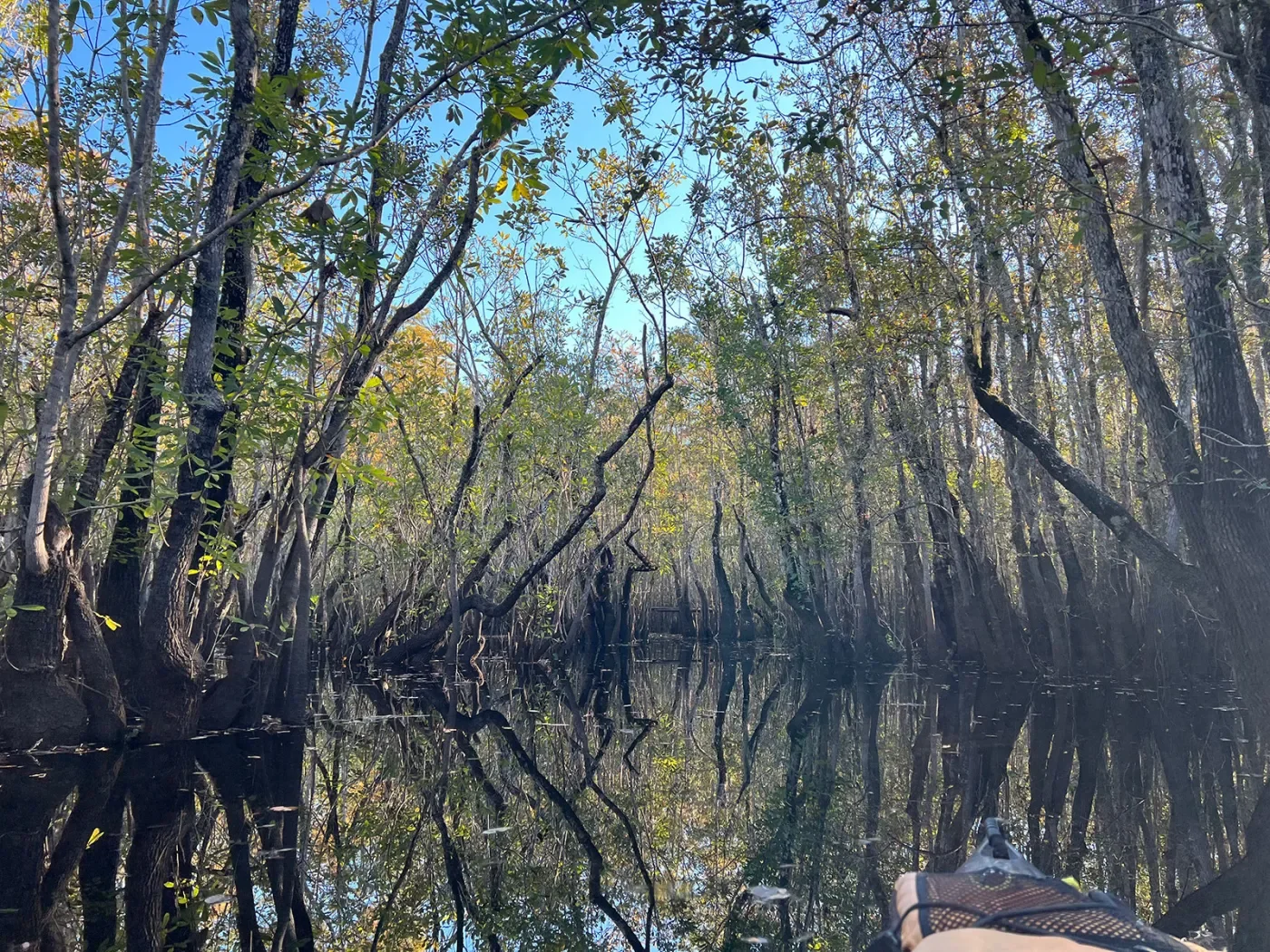Interview with Chris Watkins
Interviewed by Morgan Hunter (Outreach Coordinator) for The Dodge
Readers of The Dodge may be familiar with the name Chris Watkins from their poem in our Summer 2025 issue. In “Controlled Burn[ing] Haibun,” Watkins explores the effects of controlled burns on the Florida landscapes through the compounding redaction of text. Experimentations in poetic form are only part of the robust world of Watkins, though, as they are also a deeply impassioned environmental activist and educator. A few weeks ago, I had the exceptional opportunity to sit down with Watkins, where we were able to dive deeper into “Controlled Burn[ing] Haibun” as well as explore activism through art in preparation of their upcoming event, the Virtual Nature Writing Workshop put on by the Apalachicola Riverkeeper and co-presented by The Dodge.
Morgan Hunter: Thank you so much for joining me, Chris, and if you wouldn't mind, please feel free to introduce yourself and share a bit about your craft.
Chris Watkins: Yeah! I am a poet from Florida, I consider myself an eco-poet (so I like to write about the environment), and I consider myself a formalist. I really like to use forms, both contemporary and nonce forms, as well as ancient and received forms. I also am a trans poet, so I like to call myself a gender non-conformalist, which is a term that I coined meaning just a formalist poet who likes to play with form to talk about gender.
MH: Your poem, “Controlled Burn[ing] Haibun,” from our Summer 2025 Issue, plays with form and is very much centered around your passions with eco-writing. I would love to hear more about your inspirations for that work.
CW: It’s based on a real place, a national wildlife refuge near Tallahassee where I live, called St. Marks Wildlife Refuge, which is a longleaf pine ecosystem, so it depends on burning. Longleaf pines will only open their seeds when they are burnt and when the ground around them is burnt, and if that ground isn’t burnt [longleaf pines will not seed]. I think ideally, it’s like one to three years, but you know, the longer they go, the harder it is for longleaf pines to keep producing and for it to stay a longleaf pine habitat. So we do a lot of controlled burning in Florida, which is really great. It’s really great for the ecosystem, and it’s really great for preventing our fire-dependent ecosystem from becoming like it is out West. The form is a burning haibun, which is a form created by the poet Torrin Greathouse. It’s a play on the traditional haibun in that it uses the traditional old Japanese form where prose is mixed with haiku. The burning haibun creates a prose block, and then it does an erasure of that prose block, and then it does an erasure of the erasure into a haiku. So I thought it was fun to use the blackout as a kind of burning and her idea for the poem is that the haiku should be revealed and be within the whole thing the entire time, so the erasure is making something. I think that’s the same thing that happens in a real controlled burn that I really like.
MH: You explain it so well because you’re used to working with the form and working with your subject matter, but the connection—because I feel so many students, especially of poetry, are so hesitant to work with form, because they find it so structured, but you’re making real connections between your inspiration, physical inspiration, and these alternative and experimental forms.
CW: Yeah, and I think Torrin does a really good job of taking these kinds of older forms and turning them into this new thing that seems both rooted in this long tradition and really exciting. I also really like it because she’s a trans poet, so with the haibun, it feels like it’s connected to this long nature tradition, and then with her kind of reinvigorating it, it feels like it’s part of this amazing trans tradition. So I really love that.
“Autumn Canopy on Graham Creek” -
Photo courtesy of Dani Davis
MH: So this format, this experimental format, some would say, this reinvention of old form— how do you feel that contributes to specifically the reader’s experience?
CW: I hope it’s a little bit weird. I think that experience of seeing something torn apart or, you know, blacked out, I hope that that does kind of make people feel like, “oh, that’s weird.” The fact that it’s revealing something—I hope that’s what the reader feels. That’s certainly what it feels like to write a burning haibun. [ . . . ] I’ve written a number of them at this point. When I write them, I try to make it feel like even if I know maybe what the haiku is gonna be beforehand, at least [in] that middle section I’ve got so much erasure to do. It feels like I’m discovering the poem, and then sometimes I’m rediscovering the original prose block, because I’m trying to make something work in a lower section. I hope that the reader feels like they’re also discovering something.
MH: That was about to be my question—where do you even start working with one of those pieces? I wondered whether you started from the ground up with the haiku or if you started with the prose and worked your way down, and it makes so much sense to hear you say that it’s kind of everything all at once, and that’s so interesting.
CW: I also love the idea—I’ve never read one backwards—but I love the idea of reading one backwards. I’m like, “I need to try that at some point.” I think that’d be really cool. I need to go back and read some of Torrin’s and see how they read backwards, and then go read some of mine and see how they read backwards. I love that.
MH: I love breaking form so much.
CW: Yeah! Yeah, exactly!
MH: But switching gears just a little bit, because you are not just described as a poet; you are also often described as an environmental activist. How did you come to embrace this part of your identity?
CW: So my writing and my activism, I think, really go hand in hand. I try to make them go hand in hand. I am a lover of the natural world, obviously. I think a big, big turning point for me, when I really started writing more and more about the natural world, was moving to Florida. I actually grew up in Illinois, and now in Florida, I love the swamps, I love the wetlands here, and I consider the wetlands of Florida a really trans, nonbinary space. They’re not quite water. They’re not quite land. They’re just kind of this strange, ethereal space. Also, I’m a board member of Apalachicola Riverkeeper, and I got to be that from going on this long paddle fundraiser, RiverTrek. It’s this five-day river trip, and we raise money, and it’s, like, a charity marathon sort of situation. But I think after going on that, I really started writing a lot about the Appalach. I started writing a lot more about the climate crisis. I would say my first book is in three sections, and the middle section is all about eco-poetics, but then [in] the book that I’m working on now, it’s pretty central throughout the entirety of the book. So not that I wasn’t thinking about it before, but I’m like thinking about it more and more and more now as I go on. It’s really shaped who I am as a writer.
“Apalachicola River” - Photo courtesy of Doug Alderson
“The Apalach” - Photo courtesy of Doug Alderson
MH: It makes perfect sense—having your activism tied so much to your art—because any reader, even from just your publication in The Dodge , can see how tied you are to the world around you. I especially love the idea of wetlands and swamp being this like nonbinary, trans space because you’re right, it is.
CW: I have a piece about that in [Terrain.org]. I also kind of think it’s why people hate both wetlands and trans people because we’re really hard to define. People don’t like that. They want shit in rigid categories, and a swamp is kind of hard to define for people who want that American picket fence life. A swamp is confusing to that kind of mentality. Even though Florida might not seem like this trans paradise, I find it to be this weird place.
MH: I really commend you and your work in living in somewhere that might be very difficult politically. Still persevering for your art and for your passion like that is incredible.
CW: Thank you. I love Florida so much. Northerners often discount the South as racist, but they’re overlooking that a large portion of the population are Black people. Especially in the area where I live, there are super thriving communities of rural Black and Indigenous folks. When I was doing my PhD, I had a professor who had really long family ties to this area, both Indigenous and Black familial ties to this area, and I think some people overlook that when they think about the South. It’s something I’ve had the privilege of learning after coming down here. I think it’s really cool.
MH: There are so many people and so many different walks of life, and I specifically am very interested in terms of the people that you are working with. You have already said it, but what exactly is your involvement with the Apalachicola Riverkeeper?
CW: I'm a board member now. I started off with the organization three years ago at our biggest fundraising event called RiverTrek. A group of usually around fifteen of us will paddle the whole length of the Appalach which is a hundred, about 110 miles from its source right on the Florida-Georgia line, all the way down to the Gulf. We will paddle the whole thing in about five days and that’s where we raise the majority of our funds for the organization. I was on that trip thinking, “this is a cool organization. I’ve kind of heard of them. I like paddling, and I like nature, and this will be great.” Then I just really, really fell in love with the organization, and with this river in particular. It’s probably the most endangered river in the South, and it’s definitely the largest river by volume in Florida. It pumps out the most water of any river in Florida, and it connects us all the way up to the Appalachians. It comes from two other rivers that meet right on the Florida-Georgia line, the Chattahoochee and the Flint. So it’s also just this really cool Southern coercion, or like cohesive point, that I think just has a lot of power, and it’s really inspired my writing. We use all those funds to pay our full time staff, and to do things like […] so [for example,] we just sued this oil company and our Department of Environmental Protection in Florida because they wanted to drill in the Apalachicola River basin, and so we sued them to stop that, and then we got a bill passed to make sure that it doesn’t happen again. We’ve done a lot of really amazing work to protect the river. All of that money that we raise for RiverTrek is super important, and really helps us do that work and continue to keep this place the super pristine, amazing place that it is.
MH: Other than River Trek, you all do other workshops and events, as that’s what we’re also talking about today. The next one is coming up on October 11, and that is the Apalachicola Riverkeeper’s Virtual Nature Writing Workshop. Would you be able to share a bit more about the workshop, and then what participants might have to look forward to?
CW: Definitely. It will bring together three different teachers, instructors, whatever you want to call it. Myself, Dr. Liesel Hamilton over at [The University of Florida] who’s amazing. I’m primarily a poet, and I write a little nonfiction, but Liesel is a nonfiction writer through and through. Then CMarie Fuhrman, who is a Western writer, and I got to know her at the Elk River Writers Workshop, which is this amazing workshop out in Montana that’s based right near the Yellowstone River, which is also called the Elk River. She has this amazing book called Salmon Weather, and then this other book called Camped Beneath the Dam. So she’s both a nonfiction writer and a poet who will be bringing kind of both of those expertise as our keynote speaker. I’m really excited. It’s two people whose work I think is super excellent. I forgot to mention, Liesel is writing a book about the seasons in Florida. Seasonality in Florida is really strange,
“Tupelo, Graham Creek” - Photo courtesy of Dani Davis
because, like, our leaves don’t change until December (if they change at all). Most people think of winter as a dead time in nature, but actually in Florida, it’s when we’re most alive. It’s when all of the birds come down. It’s this beautiful, beautiful time. I’m really excited to work with these two people whose work I really admire, and to hopefully bring their expertise in both natural observation, and I mean, they’re both just killer writers too. Their observational skills, their writing skills. I’m hoping, you know, for my own writing skills too, to share some of my ideas on formalism, but also I hope the workshop as a whole can teach people how to connect that activist side to their creative side. I think CMarie is really good at that. I think Liesel is really good at that, and it’s definitely something that I try to do a lot, and I think that many writers feel called toward it.
MH: You can’t have all of the celebration of beauty of nature without ignoring everything that is forthcoming, but to focus so much on the negativity and the threats to our world, it just drains you as an artist. I think that’s a balance that a lot of young artists and activists are really trying to find right now.
CW: I want art to be this [balance]. I think a lot about and in my job, we talk a lot about eco-anxiety and people [are] like, ‘Ah, butterfly tummy! Butterflies ripping out of my tummy because I’m so anxious about all these things!’, and I do want writing to help with that. I want it to both mourn but also celebrate the earth. Sometimes it’s good to sit and cry over a poem, and sometimes it’s good to be like, ‘oh, wow, I like birds! They’re really nice!’
MH: That’s perfect. Thank you so much, Chris, for such a phenomenal conversation. It was so great to meet you, especially under this context. I am really excited to share everything we talked about today with all the readers of The Dodge.
CW: I’m super excited for it too!
For those interested in supporting the Apalachicola Riverkeeper and Watkin’s guided exploration into the world of poetic form and eco-art, consider attending the Virtual Nature Writing Workshop on October 11. The sign up link can be found here, and there are reduced and waived fees for students and anyone of financial need. For more information on the work and activism of the Apalachicola Riverkeeper, or to explore involvement in their other events, their website can be found here.
Chris Watkins is a genderqueer poet, writer, and environmental activist living in Tallahassee, FL. They earned their PhD in poetry and ecocriticism at Florida State University and currently serve as the Academics and Partnerships Coordinator of FSU’s Sustainable Campus. Watkin’s recent work has appeared in Poetry Magazine, Cincinnati Review, and The Harvard Review among other journals. Their debut collection, The Drag Gospel of Queer Jesus, is forthcoming with Saturnalia Books. To explore their work, they can be found on Instagram at @thelongleafpinebard.
Published October 6 2025




